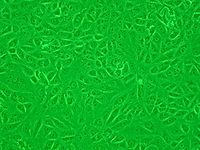
Photo from wikipedia
Simple Summary Tumors of the brain and nerves develop frequently in patients with neurofibromatosis type 1. Many are benign growths, such as pilocytic astrocytomas in the brain and neurofibromas in… Click to show full abstract
Simple Summary Tumors of the brain and nerves develop frequently in patients with neurofibromatosis type 1. Many are benign growths, such as pilocytic astrocytomas in the brain and neurofibromas in the nerves. However, in some patients, the tumors become malignant and may cause local damage, disseminate to distant sites and result in death. We studied changes in the levels of chromatin proteins and changes in telomeres, in cells obtained from mouse gliomas that are deficient in neurofibromin as well as excess brain and nerve tumor tissue from patients with neurofibromatosis type 1 or sporadic tumors lacking neurofibromin expression. A decrease in the levels of these proteins in experimental cell lines resulted in susceptibility to a class of specific drugs knowns as ATR inhibitors, which may represent a specific vulnerability of these tumor subgroups. We expect our data to provide the required rationale for the development of more accurate animal models to study neurofibromatosis, as well as specific molecularly based drugs for treatment as alternatives to the current, often devastating approaches of surgery, radiation, and chemotherapy. Abstract Subsets of Neurofibromatosis Type 1 (NF1)-associated solid tumors have been shown to display high frequencies of ATRX mutations and the presence of alternative lengthening of telomeres (ALT). We studied the phenotype of combined NF1 and ATRX deficiency in malignant solid tumors. Cell lines derived from NF1-deficient sporadic glioblastomas (U251, SF188), an NF1-associated ATRX mutant glioblastoma cell line (JHH-NF1-GBM1), an NF1-derived sarcoma cell line (JHH-CRC65), and two NF1-deficient MPNST cell lines (ST88-14, NF90.8) were utilized. Cancer cells were treated with ATR inhibitors, with or without a MEK inhibitor or temozolomide. In contrast to the glioma cell line SF188, combined ATRX knockout (KO) and TERC KO led to ALT-like properties and sensitized U251 glioma cells to ATR inhibition in vitro and in vivo. In addition, ATR inhibitors sensitized U251 cells to temozolomide, but not MEK inhibition, irrespective of ATRX level manipulation; whereas, the JHH-NF1-GBM1 cell line demonstrated sensitivity to ATR inhibition, but not temozolomide. Similar effects were noted using the MPNST cell line NF90.8 after combined ATRX knockdown and TERC KO; however, not in ST88-14. Taken together, our study supports the feasibility of targeting the ATR pathway in subsets of NF1-deficient and associated tumors.
Journal Title: Cancers
Year Published: 2022
Link to full text (if available)
Share on Social Media: Sign Up to like & get
recommendations!